Continuing with "Creating Style PARTS" ...The first thing I had said when listening to the Bass PART of the original Style
6/8 Ballad 1 Variation B was that I preferred a 'deeper' sounding Bass. OK. We'll change the VOICE for this PART to my preferred voice before we start changing/recording any PARTS.
If you have an AR, carry out the following steps (these are the same as the ones in my earlier post):
1. Get the STYLE you want up on the screen. In this case
6/8 Ballad 1 Variation B from
BALLAD.
2. Press and hold the
ACCOMP. PROGRAM button and press the
BALLAD button in the STYLE section again. Release both buttons.
3. You will be in the
BASIC screen in ACCOMP. PROGRAM. By pressing the appropriate Data Control Button under the screen, move the highlight down from
MAIN A to
MAIN B.
4. Press the button by
RECORD. By pressing the appropriate Data Control Buttons under the screen, put RHYTHM 1 and 2 onto PLAY; BASS onto PLAY; and all the others on MUTE. Remember that the START tab on the left is an ON/OFF' toggle switch'. So if you like, you can press the
START now to hear the existing Bass PART. Press
START again to stop it.
5. Press the button on the left of the screen next to
VOICE. The Voices Yamaha have chosen for this Style show across the bottom .. but not all Grand Piano as they are showing in this diagram!
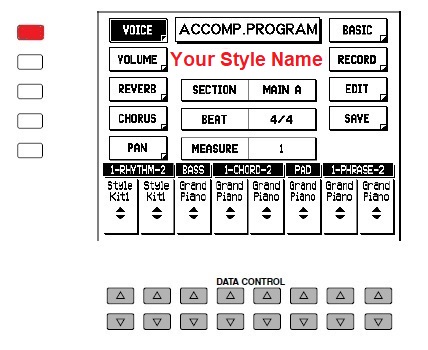
The one chosen for the BASS in
6/8 Ballad 1 Variation B is
Fingered Bass. By pressing the appropriate Data Control Button under the screen, move this UP one slot.
Acoustic Bass will now be showing.
How do you know what VOICES are available for you to choose from? Well, there are 128 altogether, and these are listed on Page 125 of the USER MANUAL .. so you'll have to go and check them out! Here are just a few of them in the Guitar and Bass sections:
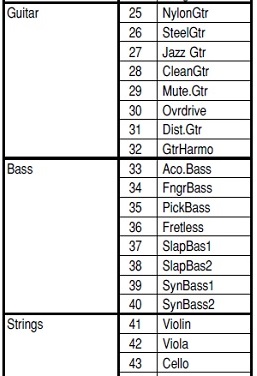
If you like, you can press the START tab to hear what it sounds like with this change of Voice .. and press START again to stop it.
Please Note: Whatever VOICE you choose for a PART,
it will be the same for both MAIN A and MAIN B. You can't have one VOICE for a PART in MAIN A and a different one in MAIN B.
Next .. I want to
change the 'pattern' of that Bass PART to something not as 'busy, and more in keeping with the song I am playing. So we now need to get the RECORD screen up again. It's as we left it, with the RHYTHM and BASS Parts 'playing', and all the others on Mute.
I always keep Rhythm 1 and Rhythm 2 on PLAY as you have to have a 'beat' going to play your 'pattern' to.
To change the 'pattern' in a PART you first have to DELETE that PART so the slot is empty. So by using the appropriate Data Control Buttons under the screen, select DELETE, and confirm with OK. We are now ready to record a new pattern for the Bass.
Well, not quite ready, as when we record our new 'pattern' we don't want to hear any other 'voices' playing with notes we press. We just want to hear that
Acoustic Bass.
1. Make sure that the
AUTO - BASS - CHORD is OFF.

2. Make sure no 'voices' are routed through to the keys ie.
All lights in ENSEMBLE are OFF.

Now we
are ready to record that 'pattern'.
Press that START .. which remember is a 'toggle switch', so we press it again when we want to STOP.
IMPORTANT: Look at the TEMPO/BAR BEAT indicator to the left of the main screen. This performs several tasks.
1. It tells you the TEMPO of the Rhythm you are about to play. You can increase or decrease the TEMPO by pressing th UP and DOWN buttons on either side. And by the way, if you didn't already know this,
pressing those two buttons together will give you the 'default' Tempo Yamaha have given that particular Rhythm.
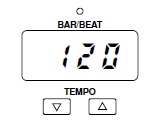
2. It 'counts' where you are in the song you are playing. The first number is the bar you have got to, and the second which beat
in the bar you have got to.
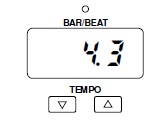
3.
And this time it will count through the 'measure' of the 'pattern'. So that first number progresses upwards as it goes through the 'measure' .. and then it goes back to 1 again and repeats itself. So watch it counting through the bars for a bit (while you compose yourself), and when you're ready, play that Bass PART for the length of the measure. Start playing the pattern at
1.1 and when it comes round to the
1.1 again
don't play anything on that beat or you will get a 'double whammy' on that first beat. See below for
which notes to play for the 'pattern'.
Note: All 'patterns' have to be done in the key of C. In fact, I should say that you play notes 'in the harmony of C' as you have to pretend you are playing C harmony all the time you are recording. So for my Bass 'pattern' (which you have already listened to earlier) I am playing this:
Click the below to listen.My Bass Part 'measure', repeatedMy 'pattern' is 6/8 time, and as I play by ear I am quietly counting 1, 2, 3, 4, 5, 6 whilst playing the notes in the right place.

For those of you who read music, I asked Peter to put my pattern into 'music notation', which he has done for me (below).

OK. So the 'pattern' is done? If you're not happy with it (I should think I would have about 5 goes at something like this before I am happy with it) you can always go to DELETE, confirm with an OK .. and then try again.
When we're happy with it we have to SAVE it. You SAVE it to a USER number. There is one more thing you could do before saving it, and that is to change the Style's NAME. Otherwise when you use it you don't really know whether it's
your Style or the original.
Go to the BASIC screen and you will see INPUT NAME, bottom left.
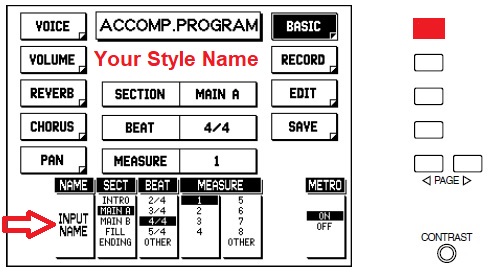
Using the Data Control Buttons under the screen you re-name your Style in the usual way.
If you wanted to SAVE your work you would go to the
SAVE screen, SAVE it to eg.
USER 1, and confirm with OK.
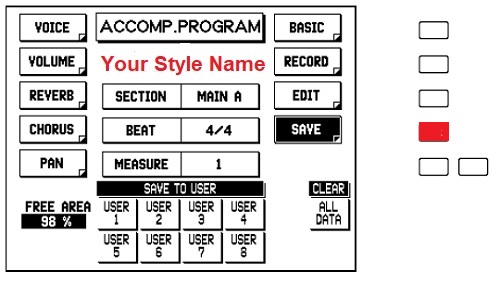
But more on this later as we haven't finished yet! We have only done one PART .. the BASS. And we still have to do the 'Arpeggio' PART and the 'Repeating Piano' PART.
But I will finish this post by saying one thing (which you may be worried about).
The 'default' STYLES in the section on the left remain 'as is' at all times. Nothing you do by playing about with the Style will affect the original. Think of it like this. The original is
copied into ACCOMP. PROGRAM, and appears on the screen. You make changes to it. This is then SAVED to a USER slot, where you can access it. Nothing is 'permanent' about a USER slot. If you load in another floppy disk it will replace those USER slots with what's on the floppy disk. So when we have finished making the changes to this STYLE we should SAVE it to a floppy disk track.